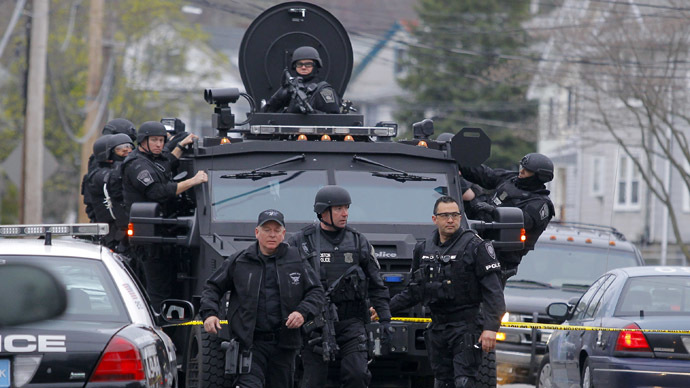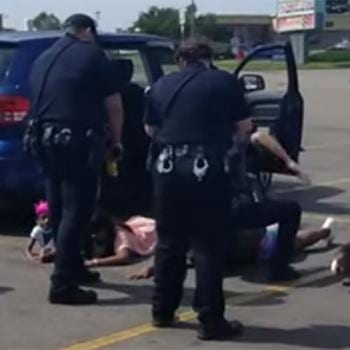I just came upon a rather startling article that may help introduce this whole “militarization of the police” thing to those new to the concept. The article is titled “‘It’s a warzone in the US’: Indiana sheriff explains why he deployed heavy armor in his county.” Here is an excerpt:
Franklin, Indiana is by all accounts the idyllic Midwestern American town. Eponymously named after one of the founding fathers and “the first American,” Franklin’s small town bona fides provided Life Magazine with a Norman Rockwell-esque scene for a bit of village life utopia in the heart of the Great Depression.
But if you were to talk to local law enforcement, a battle is raging in the streets of Mayberry.
Franklin is the county seat of Johnson Country, Indiana. Speaking with Mark Alesia from The Indianapolis Star, Sheriff Doug Cox described the 139,000-strong administrative district as a place where officers’ old-time policing just doesn’t cut it anymore.
Leading Alesia to a pole barn in Franklin, Cox shows him a MRAP – a 55,000 pound, six-wheeled Mine-Resistant Ambush Protected armored-fighting vehicle with the word “SHERIFF” emblazoned on its flank.
“We don’t have a lot of mines in Johnson County,” confessed Sheriff Doug Cox, who acquired the vehicle. “My job is to make sure my employees go home safe.”
Cox isn’t alone in believing his deputies have something to fear. Johnson County is one of eight Indiana law enforcement agencies to acquire MRAPs from military surplus since 2010, according to public records obtained by The Indianapolis Star.
All across the state, and the country, the trend is similar. From picking up military surplus to using to $35 billion in grants from the Department of Homeland Security to acquire the most advanced weapons, police forces across America are armed to the teeth.
And as Pulaski County Sheriff Michael Gayer puts it, the effects are not only tactical, but psychological.
To put it bluntly: “It’s a lot more intimidating than a Dodge.”
Keep reading, there’s more. As the article points out, there are only 13,000 people in the entire county. I read last week about the horror that followed a flash-bang grenade being tossed into a baby’s crib during a SWAT team’s drug raid—the raid found nothing, by the way—and was completely frozen at the mother’s description of not being allowed to go to her baby’s rescue, of having to stand behind the police and listen to her child’s screams, watching the blood seep through the crib. These grenades were designed for use during war, by the way. I should have realized, then, that this was a symptom of a much, much bigger problem. It’s not one SWAT team or one community. It’s everywhere.
Writing for the Huffington Post, Radley Balko noted the disturbing trend in SWAT team growth across the country.
He argues that SWAT teams in municipalities with populations between 25,000 and 50,000 have“increased by more than 300 percent between 1984 and 1995.”
By 1995, nearly 90 percent of cities with 50,000 or more people had a SWAT team. In 2000, 75 percent of towns with 25,000 to 50,000 people had their own SWAT teams as well. And those paramilitary units are not sitting idly by.
Citing Peter Kraska, a criminologist at Eastern Kentucky University, Balko says the total number of SWAT raids in America has increased exponentially, from just a few hundred per year in the 1970s, to a few thousand by the early 1980s, to around 50,000 by the mid-2000s.
According to the American Civil Liberties Union (ACLU), “disproportionately those in poor communities and communities of color – have become targets for violent SWAT raids, often because the police suspect they have small amounts of drugs in their homes.”
And with the SWAT teams comes the military hardware. In Keene, New Hampshire, a town with two murders since 2009, officials accepted a $285,933 grant from the Department of Defense in 2012 to purchase a BearCat. In Columbia, South Carolina, a MRAP which can be equipped with a 50-caliber machine gun was picked up in 2013. In the sleepy town of Roanoke Rapids, North Carolina – a town of 16,000 people, police got their hands on their own Humvees and MRAPs, which they went on to display at a car show.
And is the United States really that much more dangerous? No.


It would seem that as the U.S. is growing safer, our police are bulking up on force by buying leftover military gear. And surprise surprise, this force is being used disproportionately against minorities and those in poverty. We need to cut down on the fear and the hysteria. The 24-hour news cycle has had an unfortunate legacy: We have become afraid of ourselves, or at least, afraid of those among us. We in white America have come to believe that there is an internal threat that we must arm ourselves against—even if that means police toting machine guns and driving tanks. We must unlearn this lie if we are to fix this rift we have created and end the increasing injustice accompanying it.















